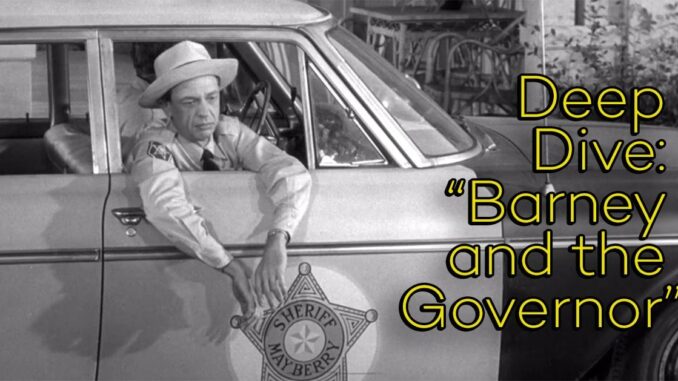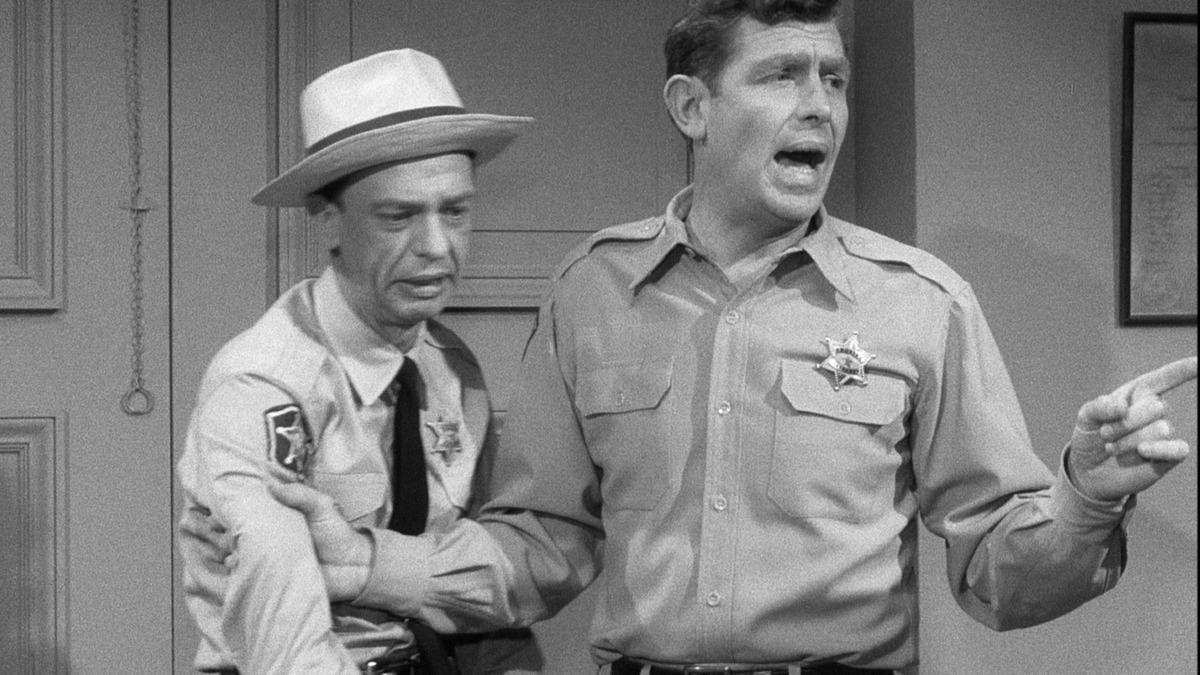
Introduction: Why We Still Obsess Over Mayberry’s Best
Let’s face it—The Andy Griffith Show isn’t just a show; it’s a comfort blanket. The town of Mayberry, with its sweet simplicity and small-town charm, is the kind of place we all wish we could escape to. And nestled among the many standout episodes is one that fans just can’t forget: “Barney and the Governor.”
But even if you’ve seen it a dozen times, chances are you’ve missed some of the subtle brilliance tucked into the script, the set, and the performances. That’s what we’re unpacking here—5 little-known details in “Barney and the Governor” that even the sharpest fans might’ve missed.
🔍 Detail #1: Barney’s Badge Number Isn’t Just Random
The Symbolism Behind Barney’s Badge
Ever noticed the number on Barney Fife’s badge in this episode? It’s “729.” While that might seem random at first, fans speculate it could reference July 29, the birthday of Don Knotts himself. Whether intentional or not, it’s a fun nod to the man who made Barney a legend.
Why It Matters
Subtle Easter eggs like this reinforce the tight-knit nature of the cast and crew. Even in the most mundane prop—Barney’s badge—the show celebrates its actors quietly and lovingly.
🔍 Detail #2: The Governor’s “Fake-Out” Entrance
The Scene You Thought You Understood
When the governor arrives in Mayberry and surprises Barney, it seems like classic comedy. But rewatch that scene closely—the camera lingers on a suspicious figure in the background moments before the reveal. It’s a blink-and-you’ll-miss-it clue that the governor isn’t just dropping by unannounced.
Director’s Crafty Setup
This is smart directing. By planting a visual seed, the episode gives perceptive viewers a chance to anticipate the twist. That’s rare for sitcoms of the era, which usually relied on more overt storytelling.
🔍 Detail #3: The Governor’s Chauffeur Is a Familiar Face
Background Extra Turned Recurring Character?
The man driving the governor isn’t just any extra. He’s actually played by the same actor who later appears as a background deputy in several episodes. The Andy Griffith Show frequently reused character actors in minor roles—sometimes even dressing them differently in the same season.
Budget-Smart or Brilliant Continuity?
TV in the ’60s was shot on tight budgets, but this reuse of actors gave Mayberry a weird kind of continuity. Whether intentional or not, it adds to the small-town vibe where “everybody knows everybody.”
🔍 Detail #4: Barney’s Tie Changes Mid-Episode
Wardrobe Malfunction or Intentional Joke?
Sharp-eyed fans have noticed that Barney’s tie actually changes in the middle of the episode. During one scene he’s wearing a patterned tie, and in the next—it’s plain. Was it a wardrobe error? Maybe. But considering how often Barney’s character tries to appear “important,” it might’ve been a sly visual gag.
The Hidden Humor in Visual Details
Don Knotts played Barney with exaggerated seriousness. A sudden change in tie could be read as him prepping for a big encounter—maybe overcompensating for nerves. Either way, it’s a laugh for viewers paying attention.
🔍 Detail #5: Opie’s Reaction Tells Its Own Story
The Silent Acting of a Child Star
Ron Howard’s Opie doesn’t say much in this episode, but watch his expressions closely—he’s clearly watching the adults and learning. His eyes follow Barney’s outbursts and Andy’s calm responses with subtle shifts. It’s a masterclass in silent acting for a kid.
Foreshadowing Opie’s Maturity
This small detail reminds us that Opie isn’t just there for cuteness—he’s observing, absorbing, and evolving. Moments like this hint at his eventual growth into a more central figure, especially in later seasons.

💡 Bonus Detail: Mayberry’s Clock Always Reads the Same Time
The Clock That Doesn’t Tick
If you freeze a few office scenes in “Barney and the Governor,” you’ll notice something odd: the wall clock never changes. In multiple scenes—no matter how much time supposedly passes—it’s stuck at 3:35.
Why It’s a Big Deal for Set Design
This wasn’t a mistake—it was practical. Clocks with ticking hands were noisy and hard to sync for multiple takes. Still, once you see it, you can’t unsee it. It adds an unintended quirkiness to the already peculiar Mayberry universe.
A Closer Look at the Episode’s Impact
How “Barney and the Governor” Reflects the Series Themes
This episode is classic Mayberry: a humble man confronts high authority—and ends up being celebrated for it. It blends humor, humility, and heart, capturing the core of what The Andy Griffith Show stands for.
The Genius of Don Knotts in This Episode
Why Barney Fife Stole the Show Again
Barney isn’t just a comic sidekick—he’s the emotional engine of many episodes, and nowhere is that clearer than here. His overreaction, his backpedaling, and his final redemption are all wrapped in Knotts’ perfect comedic timing.
Andy’s Role as the Quiet Mediator
Why Andy Always Lets Barney Shine
Andy could easily outshine everyone—but he doesn’t. He takes a backseat, allowing Barney’s flaws (and growth) to play out. In doing so, Andy becomes the glue holding Mayberry together.
The Episode’s Take on Power and Pride
Small Man vs. Big Office
The interaction between Barney and the Governor isn’t just funny—it’s insightful. It taps into a timeless theme: what happens when everyday people confront power. Instead of humiliation, Barney gets dignity. That’s Mayberry in a nutshell.
The Script Was Sharper Than You Remember
Snappy Dialogue with Hidden Layers
There’s wit beneath the surface here. Take a second look at some of Barney’s lines—they’re not just funny, they’re character-revealing. His vocabulary, his pacing, his attempt at formal language all add to the layered writing.
Rewatch Value: Why This Episode Keeps Giving
You’ll Spot More Each Time You Watch
Like a great painting, “Barney and the Governor” offers more the closer you look. Every viewing brings new appreciation for the writing, the direction, and the performances.
How This Episode Helped Cement the Show’s Legacy
A Blueprint for Comedy with Heart
Episodes like this set the tone for countless family-friendly sitcoms that followed. It balanced big laughs with big hearts—a blueprint that still works today.
Final Thoughts: Why We Still Love Mayberry
It’s not just nostalgia. It’s not just black-and-white charm. It’s because Mayberry shows us what community, kindness, and comedy can look like when blended just right. And “Barney and the Governor” is a perfect slice of that pie.
Conclusion: Look Closer, Laugh Louder
If you ever thought you’d seen everything The Andy Griffith Show had to offer, think again. Hidden in plain sight are clever touches, background humor, and storytelling choices that show just how rich the series really is. So next time you’re watching “Barney and the Governor,” keep your eyes peeled—you never know what you’ll catch the second (or fifteenth) time around.
❓FAQs
1. Was the Governor in “Barney and the Governor” based on a real political figure?
Not directly. The character was fictional, but he reflected the idealized leadership often portrayed in 1960s TV—respectable, humorous, and open to the common man.
2. Did Don Knotts improvise any of his lines in this episode?
While most of the script was tight, Knotts was known to add personal flair to his delivery—his pauses, nervous gestures, and inflections often came from his own instincts.
3. Is “Barney and the Governor” considered one of the top episodes?
Yes, it’s often listed among fan favorites due to its mix of comedy, heartfelt moments, and standout performances by both Don Knotts and Andy Griffith.
4. How many times did Barney Fife threaten to quit the force?
Multiple times! It became a running gag. Barney’s passionate nature often led him to dramatic resignations—only to return soon after.
5. Were any real politicians ever fans of the show?
Absolutely. The Andy Griffith Show had broad appeal, and many U.S. presidents, including Lyndon B. Johnson, reportedly enjoyed it. The values it upheld resonated far beyond Hollywood.
